Sweeps: This is an optional rule that is sometimes added when playing
Cassino or any of its variations. In this variant rule, a player who on
his turn, manages to take all the cards on the table is said to have
earned a sweep. Each sweep entitles a player to one point at the end of
the hand. A player who earns a sweep, should place one of the cards
taken in the sweep at a 90 degree angle in their face down capture stack
to assist in determining and calculating the scoring at the end of each
hand. When totaling the scores at the end of each hand, sweeps are the
last point category to be scored, immediately after each of the Aces.
Suipi: Suipi is a variant of Cassino that is highly popular in Samoa. This variant is sometimes also called Sweepy. The game is identical to the standard game of Cassino as described, with only the following differences:
- At the start of the game, each player receives eight total cards to form his hand. After the last player has played the last of his cards as normal, another eight cards are dealt to each player. After all players have played this second set of eight cards, a last distribution of eight cards is dealt to every player by the dealer.
- As in most other forms of Cassino, four cards from the deck are placed face-up in the middle of the table. If, within these initial four face-up cards there are any duplicated cards, all the duplicates should be shuffled back into the deck and replaced with new cards from the deck. Similarly, if any of these four cards are specific point scoring cards (any Ace, the ten of diamonds or the two of spades) these cards should also be shuffled back into the remainder of the deck and replaced with new cards from the top of the deck.
- If a player manages, with his play, to capture all the cards from the table, he has performed a "Suipi" which entitles that player to earn one point. He must loudly announce "Suipi!" as this occurs. The next player in turn must simply play any card from their hand to the currently empty table.
In any and all other aspects Suipi is played identically to the standard version of Cassino as described above.
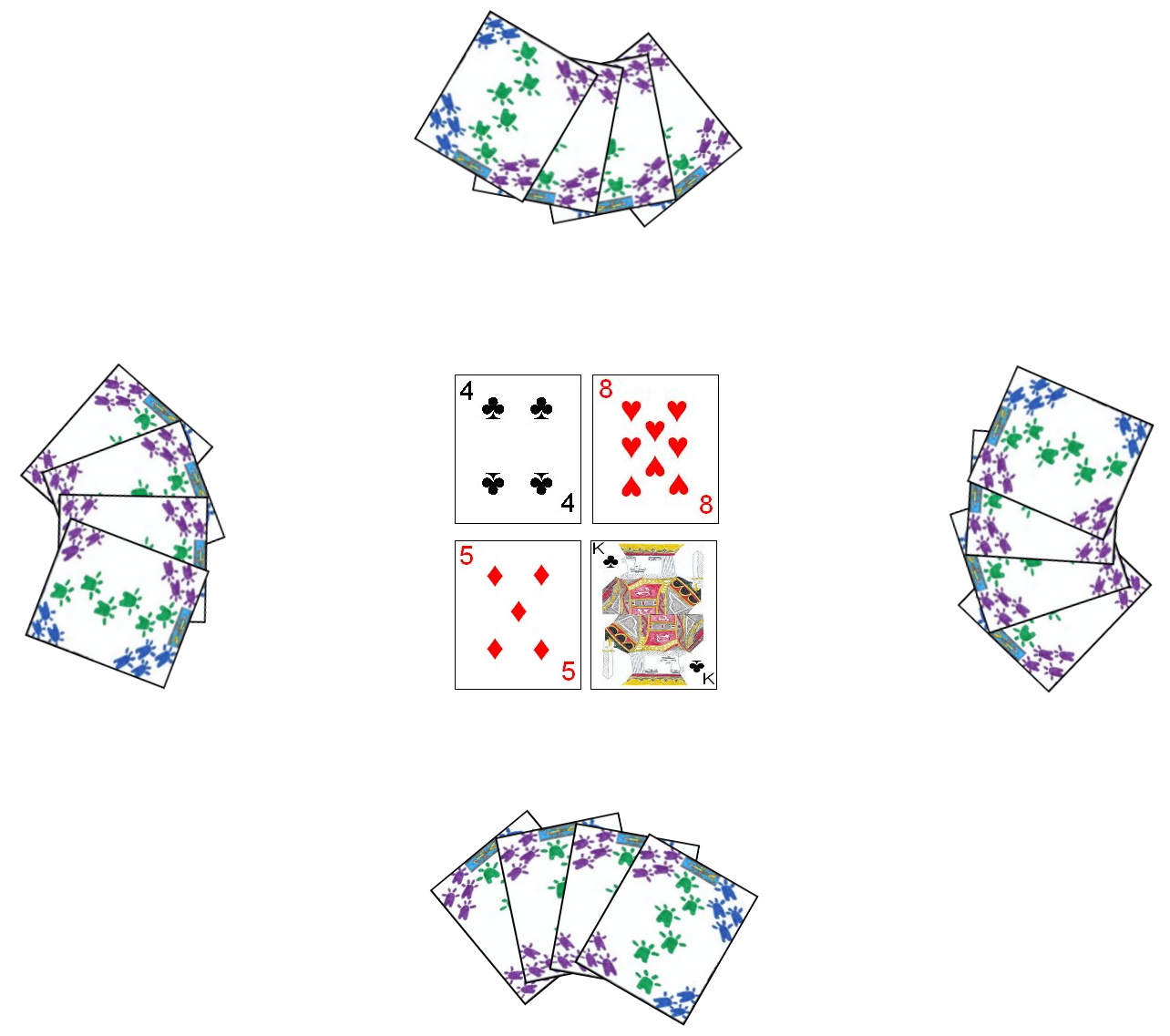 Partnership Cassino
Partnership Cassino: This variation of the basic game is designed for four players, playing in two opposing partnerships.
The partnerships can be chosen in various ways. A common method to do this is to have all four players draw a card from a shuffled deck. The two players drawing the highest cards play as partners against the players drawing the two lowest.
The partners should sit opposite each other at the table (as in most other partnership type games), such that the turns will alternate between a player from each partnership.
The game is played identically to the standard game of Cassino, above, however all cards taken by each partnership are combined into one scoring pile for that partnership. As in the standard game, a player may only make a build
equaling a total that they contain in their own hand. They may not attempt to build a total for a card rank that they do not hold in their own hand, but which they think their partner might have. At the end of the hand, the partnership as a whole scores for all point earning
cards and combinations captured by that partnership.
Just as in the standard game, the first partnership to score a total of 21 points or more wins the game.
Draw Cassino: This game is played exactly the same as the parent game above, with one major exception.
After the initial hands are dealt (along with the four face-up cards to the center of the table) the remainder of the stock is placed face down in the center of the table as a stock pile.
After each player takes his turn, he draws the top card of the stock pile and adds it to his hand
to replenish his hand back to four cards.
When the stock pile is exhausted, the game continues as in the standard version until the players have each played their last card.
In all other respects this version is played the same as the standard version of Cassino.
Kontsina: Kontsina is another game which plays much like standard Cassino. It is designed for play by two using one standard fifty two card deck. The card game Kontsina is Greek in origin and is sometimes played under the name Koltsina or Kolitsina.
The election of the first dealer can occur in a number of ways with draw
for high cards a common method. After each hand the role of dealer
should alternate amongst the two players. A number of hands should be
played in which each player has taken the role of dealer an equal number of times, as the dealer has a slight disadvantage in this game.
As in standard Cassino, after the cards have been shuffled and optionally cut, the dealer deals each player a hand of four face-down cards and a layout of four face-up cards to the middle of the table. The remainder of the deck should be set aside for use after the initial four cards dealt to each player have been played. The opponent of the dealer has the first play in each hand.
On a player's turn, that player plays one card from his hand to the table. In general, the goal is to capture cards from the center layout so players will usually play cards with this goal in mind. If a player is able to play a card of the exact same rank as another card already found in the layout, he may then capture that card. The card played and the card captured are thus added to a face-down capture pile retained by that player until the end of the hand. If there are multiple cards on the table which are of that same rank, only one other card can be so captured during that play. Similarly, if a player can play a card to the table of which two or more cards from the table sum to, he may capture those cards along with his card played, adding them to his capture pile. Aces have a capture value of one for this purpose, and Jacks, Queens and Kings can never be captured nor may they capture other cards by summing. Only one group of cards summing to the total of the card played can be captured on a turn. Lastly, if a player has no legal play in which he could make a valid capture (or chooses not to make such a capture), he simply plays a card face-up to the table, adding it to the collection of any cards already found there.
The players continue, alternating turns until they have played all four cards as originally dealt. The dealer then takes the deck and deals four more cards to each player from the deck, again placing the remainder of the deck aside.
Gameplay continues in this manner until the deck has been depleted, and the players have played the last four cards dealt. Once this occurs, the game ends. The last player to have made a legal capture during the hand is entitled to collect any cards still remaining on the table and add them to his capture pile. After this, each player then reviews his collection of captured cards and scores points accordingly, as per the following chart:
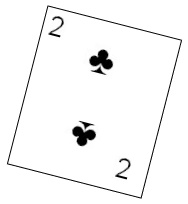 |
|
| Holding | Description | Score Earned |
|---|
| The Cards | Player capturing the most total cards during the hand | 2 |
| The Clubs | Player having captured the most total cards in the suit of clubs(♣) | 2 |
| The Good 2 | Two of clubs (♣) | 2 |
| The Good 10 | Ten of diamonds (♦) | 1 |
|
|
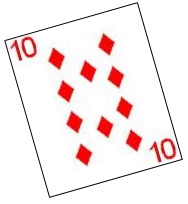 |
If each player captures exactly 26 cards, the 2 points for the "Cards" category is not awarded on that hand.
Whichever player earns the majority of points on each hand is said to have won that hand or round. A tally is kept of the number of these rounds won by each player, and after a pre-determined set of hands has been played, the player who has won more such hands is declared the overall game winner.
Diloti: Diloti is a game played similarly to Cassino which originated in, and is commonly played in, Greece and appears to be an elaborated form of Kontsina. Due to the intricacies of the game, Diloti is said by some to be the most
strategic of the games of this type. Standard Diloti is generally designed for play by two players, but a four player variant will be described further below. Diloti is played using one standard 52 card deck.
Determination of the first dealer can be performed using any method, such as draw for high card, with the player thus drawing the highest card set as the first dealer. After each hand, the role of dealer alternates amongst the two players.
After the first dealer has been determined, this player should thoroughly shuffle the deck and offer it to his opponent to cut. After the cut, he begins dealing the cards. The deal consists of the dealer first dealing six face-down cards to his opponent and then dealing six face-down cards to himself. The dealer then places the next four cards from the top of the deck face-up on the table to form the layout. If, in these four cards dealt to the table, there are three or four cards of the exact same rank (i.e. four Kings)
and these are Royalty cards, these cards should be reshuffled back into the deck and four replacement cards dealt to the table. After the deal of these four face-up cards to the table, the remainder of the deck is set to the side,
temporarily out of play. The opponent of the dealer has the first turn, and the turn thereafter alternates amongst the two players.
On each turn a player selects any one card remaining in his hand and plays it to the center layout. In this play, the player may take one of the following actions, as appropriate and able:
- Matching Rank Capture:
If a player manages to play a card of the exact same rank as one or more other cards currently on the table, that player may capture not only those matching cards but his own card as well. If the card matched is a
royalty card (King, Queen, or Jack) and there are two or more cards of that same rank, the player may only capture one such matching card.
- Summing Rank Capture:
If a player plays a card on which two or more cards already on the table sum to a total of, he may capture not only those cards summing to that value, but also his own played card as well. Furthermore, if there are multiple combinations of other cards which sum to this same total he may capture those cards as well. For purposes of summing
royalty cards do not have a value (and thus cannot be captured in this way, Aces have a summing value of one, and all other cards a summation value equal to the value marked on the card).
- Declare:
A declaration is a move in which the player takes one card from his hand and combines it with one or more non-royalty cards from the table. There are several types of these legal declarations which can be made:
- Plain Declaration:
A plain declaration (also sometimes called a join) is one in which one card is added to multiple other loose cards already on the table. The capture value of this declaration
is equal to the sum total of all the cards comprising the plain declaration. The cards in the declaration are all added in a
face-up pile and left on the table. The player making this declaration usually will announce the sum value of the declaration when making it and must also hold a card in his hand which sums to the total value of the declaration.
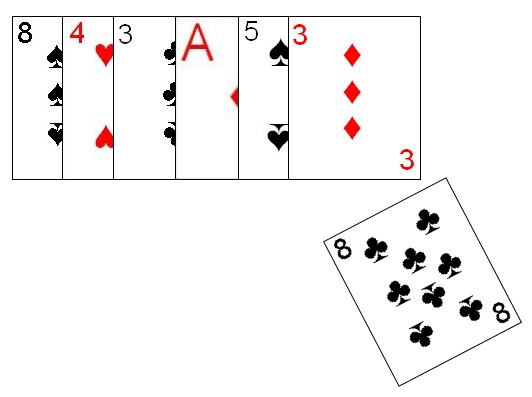 |
Family Declaration
This shows an example of a family declaration with a capture value of eight. Thus, play of another eight on a player's turn will allow him to capture the declaration.
|
- Family Declaration:
A family declaration (sometimes called a group declaration or soy) is a declaration in which the pile of cards formed contains multiple combinations of cards, or single cards, that sum to a specific total (i.e. a pile containing an eight, a four, three and Ace, and a five and a
three, would consist of three combinations totaling eight all included in one declaration). To make such a declaration, the player plays one card from his hand and combines it with one or more cards from the table to make a pile containing multiple combinations of a specific total. The player making this declaration should announce the summing value of the declaration and must hold in his hand a card of the value of that declaration. Cards which form a plain declaration may also be added to a family declaration, with the requirement that the value of the plain declaration is equal to the specific sum value of the group declaration. Note that a player could raise an existing declaration, and on the same turn add it to existing cards on the table to form a group declaration, if able.
- Raise a Declaration:
If there is an existing plain declaration already on the table, created or last raised by an opponent, a player may add a numerical card to the pile of cards which comprise that declaration, which will thus increase the value of the declaration. The player would then announce this new, increased sum value of the declaration. The player must also have a card in hand that totals to this new value in order to raise a declaration. If an already raised declaration is already on the table, a player may again raise the declaration value, providing he has another card in hand equal to the new total of the re-raised declaration. A family declaration may never be raised.
- Capture a Declaration:
If a player has a card which equals the summation value of a declaration currently found on the table (whether his own or an opponent's) he may capture that declaration along with his card played.
- Laying:
If the player cannot, or elects not to make any of the above plays, he may simply play any card from his hand face-up to the table, leaving the card on the table. However, if the played card matches one or more other cards in rank already on the table he must capture his card and the matched card or cards.
In the event of any cards which are legally captured during a player's turn, these cards are added to a face-down capture pile retained by the player. At the end of the hand, the cards in this pile will be examined for scoring purposes. If a player has created an as-of-yet uncaptured declaration on the table, he may not lay off cards to the table or raise the value of an existing declaration on the table. Note that if a player plays a card which can capture other individual loose cards of the same denomination as well as multiple loose cards that sum to the value of the card played, he may capture all those cards, as well as the card played to make the capture.
If a player manages to capture every face-up card on the table during his turn, this is called a Xeri, and entitles the player to extra points at the end of the hand. This is usually represented by placing one of the captured cards at the bottom of his capture pile, face-up and at a 90 degree angle to the rest of the pile. However, if the first player of the game, on the first turn manages to capture those first four cards on the first turn, this does not score as a Xeri.
Once both players have depleted all six cards dealt to him during play, the dealer then deals six more cards to both players, starting with his opponent from the remainder of the deck. He does not, however, deal any additional cards to the table after the initial four cards have been dealt there. After these cards have again been played out, the dealer deals another round of six cards to each player, continuing this until the deck has been depleted. The players then play these last cards from the hand to the table. After the last play, if there are any cards remaining on the table, these cards are added to the capture pile of the last player to have made any legal captures. This would not count as a Xeri, as the cards were not actually captured by the player through play of a card to the table.
Once the deck has been depleted and all cards played, each player then reviews the cards in his capture pile for scoring purposes. The following are all the valid scoring categories used in the game of Diloti:
| Holding | Description | Scoring Value |
|---|
| Most Cards | The player having captured the majority of the cards. If both players manage to capture exactly 26 cards no player scores for this category on this hand | 4 |
| Ace | Each Ace Captured | 1 Point Each |
| The Good Ten (10 ♦) | Capturing the ten of diamonds | 2 |
| The Good Two (2 ♣) | Capturing the two of Clubs | 1 |
| Xeri | Capturing every card on the board in one play.
Also called a sweep. | 10 Points Each |
After each hand, the total points as scored by each player is added to an accumulating total for the player. If either player has reached or exceeded a total of 61 at the end of a hand, that player is declared the winner of the game. If both players manage to reach or exceed 61 points, the player with the higher total is declared the winner. If both players manage to reach or exceed 61 points, and both players have the same score, additional rounds must be played until one player has a higher score at the end of a hand.
Four Player Diloti: Diloti can also be played by four participants. Four player Diloti is essentially a four player, partnership version of Diloti, played similarly to the standard version. Each player should sit directly across the table from his partner during every hand. Other than the number of players, and the introduction of partnerships, the game is played similarly to the two player game, with the following differences:
The dealer deals the hands in a counter-clockwise direction around the table, starting with the player to his immediate right. Due to the increased number of players, there will only be one additional deal during each hand. Rotation of play is also in a counter-clockwise direction, as does the role of dealer after each hand.
A player may is not obligated to capture a declaration made by his partner, but may if able. He may also not raise a declaration created by his partner (unless a member of the opposition has previously raised that same declaration) but he may add additional cards or sums of cards an existing declaration of his partner to create a family declaration. However, if a player adds additional cards to an existing or new group declaration made by his partner, it then becomes this player's responsibility to capture this declaration.
At the end of each hand, all cards captured by both members of a partnership are combined before scoring of the hand. Thus, all points awarded during a hand are awarded to a specific partnership rather than individual members of that partnership.
In all other aspects the four player version of Diloti is played identically to the two player game.
Royal Cassino: This game is played similarly to the basic game above, with one major exception:
In this version the royalty cards have equivalent rank values for use in building or taking builds. These cards have values as follows:
| Card | Equivalent build value |
|---|
| Jack | 11 |
| Queen | 12 |
| King | 13 |
| Ace | 1 or 14 at holders option |
|
|
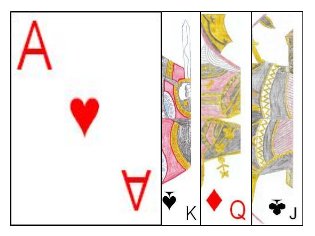 |
|
|
Thus, for example, a King could be taken not only by a matching King from the hand, but could also be used to take a number of cards on the table that
totaled to 13. These royalty cards can be built and used to take builds just as any other card in the game. A player holding an Ace can use it as either a rank of 1 or 14 at their option. They can do the same for an Ace on the table, as long as it is not already part of another build, in which its value has already been declared. When using an Ace in a build, the player must declare what
rank they are building. Differing from the standard game, a player can take any number of equally ranked cards with a royalty card from their hand (they are not limited to just one or three). In all other respects the game is played exactly as standard Cassino.
Haitian Cássino: Haitian Cássino is the variant of Cassino that is very popularly played in the country of Haiti. It is played similarly to Royal Cassino with the following differences.
- Haitian Cassino is usually played by four players, each playing independently.
- A player is entitled to make multiple captures on his play, providing each of these would each be a legal capture with the card played.
- Uncaptured cards left after the last cards have been played remain in the middle, belonging to none of the players.
- After all the cards have been dealt and played, the players each count their captured cards, with the player having the most total captured cards declared the winner.
Other then these few differences, this game is played identically to Royal Cassino as described immediately above.
Swedish Kassino: Swedish Kassino is, as is made obvious by the
game's name, a Swedish variant of the popular fishing game, Cassino. The game is also sometimes played under the names Nordic Cassino or Norwegian Cassino. It is designed for play by 2, 3, or 4 participants using one standard 52 card deck. The game is played identically to Royal Cassino with the following differences:
- Building, as is used in standard Cassino and Royal Cassino is not used or allowed in Swedish Kassino.
- A player is never required to capture any or all the cards he might be entitled to capture on his turn.
- A player managing to clear the table by capturing every card, called a tabbe, will earn an additional point for this feat at the end of the hand. To signify a sweep, one of the cards captured is placed face-up in the capture pile, while all other cards captured in the capture pile at any time are placed face down.
- In dealing the last deal of four cards from the deck on each hand, the dealer must announce this by stating sistan or båt.
- After the last cards have been played, whichever player was able to make the last capture in the hand, is entitled to all the cards remaining on the table. This does not normally qualify as a tabbe, unless the last card played by the last player does, in fact, clear the table of all cards.
- In addition to collecting all remaining cards on the table, the last player to have made a capture during the hand earns a bonus score of one point (called sistan, for last).
- At the end of each hand, after all cards have been played, each player reviews the cards he managed to capture during the hand. The following chart shows the various scoring opportunities during the game:
| Holding | Score Earned |
|---|
| Player having captured the most cards | 1 |
| Player having captured the most spades (♠) | 2 |
| Ten of diamonds (10 ♦) - Known as Storan or "The Big One" | 2 |
| Two of spades (2 ♠) - Known as Lillan or "The Little One" | 1 |
| Each Ace captured | 1 |
| Last Capture - Called Sistan | 1 |
| Tabbe (clearing the board) | 1 Point Each |
If two or more players tie for most cards or most Spades, no player scores for that particular category.
- After the scores are calculated at the end of each hand, the accumulated scores, over several hands are compared. If any player has managed to reach or exceed 16 points, that player is declared the winner. If two or more players have reached or exceeded this total, the player with the highest total score is declared the winner. If multiple players tie with the highest score, the player who, on the last hand, captured the most cards in the
spades suit is declared the winner.
In all other aspects Swedish Kassino is played the same as Royal Cassino described directly above.
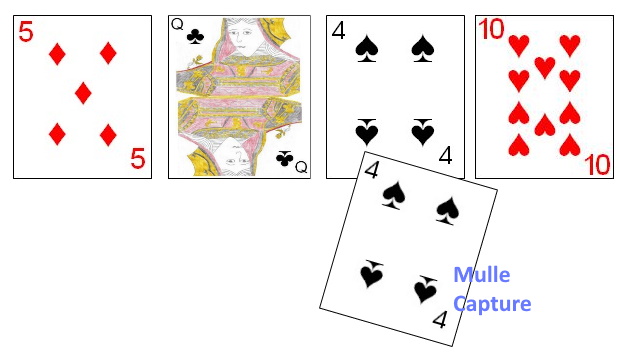
|
| A Mulle capture in the game Mulle, earning this player one bonus point. |
Mulle: Mulle is another Swedish variant of Cassino and is played very similarly to Swedish Kassino with a few differences:
- In playing Mulle a double deck is used. Thus before the start of each game, two standard 52 card decks are combined and shuffled together. Due to the larger number of cards used in the game, there will of course be more deals played during each hand.
- The scoring categories are similar to Swedish Kassino, however the score for the player collecting the most cards during the hand is not used or awarded.
- An additional opportunity to earn points during the hand is introduced, called the Mulle. Thus, in this game, if a player on his turn captures exactly one other card, and the card captured is identical to the card played (in both rank and suit), the player doing so earns one bonus point. This score is called Mulle, which also gives the game it's name.
In all other aspects Mulle is played identically to the game of Swedish Kassino, as described above.
Finnish Kasino: Finnish Kasino (as played in Finland) is another game which is played very similarly to Swedish Kassino. In fact, the game is played identically to Swedish Kassino, save the following differences:
- The game is most commonly played by 2 players, but is also occasionally played by 3 or 4.
- The values of the individual cards for summing and capturing is the same as in Swedish Kassino, with a slight different in that of the Aces, as well as the two of
spades (Small Kasino) and the ten of diamonds (Big Kasino). If found on the table, an Ace is considered to have a value of 1, however in a player's hand an Ace is considered to have a value of 14. The two of
spades, if on the table has a capture value of 2, but if played from the hand, this card has a capture value of 15. Lastly, the ten of
diamonds has a capture value of 10 found on the table but a value of 16 instead if played from the hand.
- At the end of the hand, the scoring categories for Finnish Kasino are as follows:
| Holding | Score Earned |
|---|
| Player having captured the most cards | 1 |
| Player having captured the most spades (♠) | 2 |
| Ten of diamonds (10 ♦) - Big Kasino | 2 |
| Two of spades (2 ♠) - Little Kasino | 1 |
| Each Ace captured | 1 |
| Mökki (clearing the board) | 1 Point Each |
If there is a tie for the most cards captured, no player scores the
point for most cards. If there is a tie for the most spades captured
(possible in a 3 or 4 player game) by exactly two players, each of those
players earns one point. If there is a tie by three or more players, no player scores for most
spades captured on that hand.
- During the normal game scores for Mökki (or Sweep) are calculated. However, if all players have at least one Mökki, these cancel out, with each player not earning the score for one sweep during that hand. The same also applies if each player has two sweeps or even more, with identical numbers of sweeps canceling out the same number of sweeps from every player.
- During the play of the last four cards dealt during each hand, no scores are earned for a Mökki.
- At any time during the game, if one or more players have a total
accumulated score of 10 or more, scores for Mökki are no longer counted for any player.
- Points earned for Big Kasino, Little Kasino and the Aces are awarded
immediately as captured during the hand, while all other scoring categories occur at the end of the hand. Because some scores are earned during the game, a game can end with a player declared the winner while a hand is
still in progress, if any player manages to reach or exceed 16 points during
that hand.
- If there is a tie at the end of a hand, with multiple players reaching or exceeding 16 points, the scoring categories are awarded in a specific order, with the first to reach or exceed the required score declared the winner. Thus, the scores for Aces, Big Kasino and Little Kasino are scored first. If, after these scores are calculated, there is still a tie for highest score over 16, the score for
"Most Spades" is awarded to the appropriate player, and lastly the score for
"Most Cards".
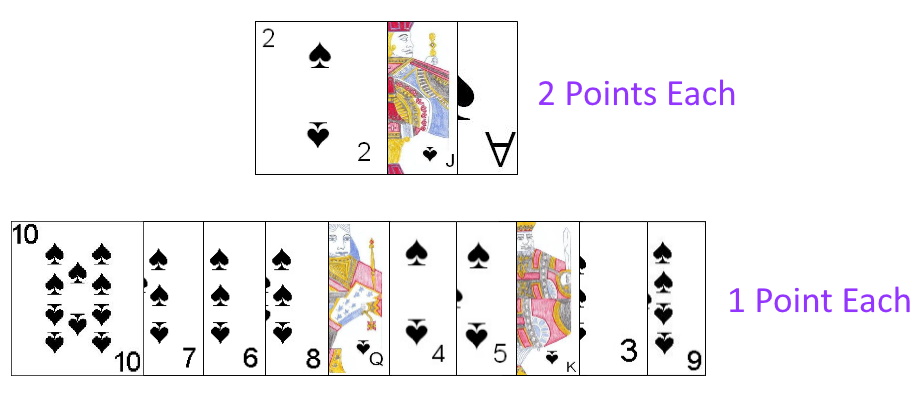 Spade Cassino
Spade Cassino: This game is played identically to the standard game described above, with the addition of several new scoring cards:
The deuce (2) of spades (♠), Jack of spades, and Ace of spades are worth
2 points each. All other spades score one point each. The other scoring
cards and criteria are as in the standard Cassino game. As this can be a
high scoring game, the point total required for a win is usually 61 points. For convenience, this game is often scored on a cribbage board, with the first player to go once around
the board (for the requisite 61 points) being declared the winner.
California Cassino: California Cassino is another form of Cassino
which is very similar to the standard game. The following detail the only differences between California Cassino and the standard game described above:
- Sweeps are never used or counted in California Cassino. While some variations of Cassino feature scoring points for a Sweep (clearing the entire table of cards) California Cassino never allows a score for any type of sweep.
- A player can capture any number of face cards from the table. In the standard version, these face cards must be paired in multiples of two. In this variation, any number of the same denomination face card can be captured from the center of the table.
- California Cassino is designed to be played by 2, 3, 4 or 6 players, each playing for himself.
- A game continues until each player has dealt exactly twice. After each player has dealt two times the game ends and the player with the highest score is set as the winner.
All other rules for California Cassino are the same as for standard Cassino as detailed above.
Cassino For Three or Four: This is basically the standard game played by three or four players. As opposed to Partnership Cassino described above, each player in this game plays for himself. The rules are exactly the same as for the standard game, however there will be a few differences due to the number of players.
For starters, after the first dealer is selected (which
is usually done through a draw for high card) the dealer begins by dealing two face down cards to each player in a clockwise rotation, starting with the player to his immediate left. After all the other players have two cards, the dealer then deals two cards face up to the center of the table. He then deals two face down cards to himself. He then repeats this procedure once more. As in the standard game, for subsequent deals of the same hand, he deals in the same way, however no new cards are dealt to the center of the table.
At the end of a hand, if the game has not yet been won, the deal rotates clockwise around the table. The deal of each hand will continue to rotate around the table, from player to player until the game ends in a victory for one of the players. The winner of a game begins the deal for the next game which then proceeds in the same way.
Because there are more players than in the standard game, there will be fewer deals per hand. With three players there should be four deals per hand. With four players there will be 3 deals per hand.
With more than two players in the game, there may be occasions where there is a tie for the player who captures the most spades in a hand. If this is the case, the score for spades is not scored in this hand. In the same manner, if two or more players tie for the most cards captured in the hand, the 3 points for cards is not awarded during this hand.
Five Player Cassino: A five player variant of Cassino has also been devised. The game is played identically to the three or player variant, with a few variants to allow the cards to be distributed evenly:
- The two of diamonds, two of hearts and two of clubs are all removed from the deck and set aside not to be used during the game.
- On the last deal of each hand, each player is dealt five cards vice the usual four to allow the last of the cards in the deck to be evenly distributed to the five players.
Other than these minor differences the five player variant is played identically to the three and four player variant of the game.
Pluck Cassino: Pluck Cassino is a more recent variant of Cassino and it's many variations. Pluck Cassino is played exactly the same as standard Cassino, as described at the top of this page, with one additional optional rule included.
This additional rule is called the Pluck. Each
player is entitled to, one time during each four card deal, perform a
Pluck. This Pluck is performed either immediately before or after a
player takes his normal turn. The pluck consists of that player
selecting any one card from the table and adding it to his current pile of
captured cards. However, there are a few stipulations on which cards can be so plucked. First, this card cannot be part of a current, existing build already found on the table. Additionally, a player cannot Pluck a card at the end of their turn that
they have just played to the table on that same turn. A player may never Pluck a direct point-scoring card (specifically any Ace, the ten of
diamonds or the two of spades). Lastly, a player may never Pluck the last card remaining on the table. Plucking does not count as a capture for purposes of determining which player may have made the last capture during the hand.
Other than this
added option of Plucking, Pluck Cassino is played identically to standard Cassino.
African Cassino: African Cassino is a variant of Royal Cassino in which players, in augmenting builds on the table, may capture the top card of other players captured piles. It is most popular in the Swaziland area of Africa and this version is thusly often called Swazi Cassino.
The version described first is for 3 players, each playing for themselves. Variants for two and four players are described further below. The dealing rotation, play and dealing privilege all rotate in a counter-clockwise rotation.
For purposes of creating builds, each of the cards has an equivalent value as per the following chart:
| Card | Build Value |
|---|
| 2 - 10 | Value marked on card face |
| Jack | 11 |
| Queen | 12 |
| King | 13 |
| Ace | 1 or 14 at the Option of Player |
To begin the dealer shuffles the deck and the player to his immediate right draws four unseen cards from the middle of the deck. These cards are placed individually and face up in the center of the table to start the center layout. The dealer then deals out the remainder of the cards to the players in rotation, one card at a time,
face-down.
The player to the dealers right makes the first play.
The play is similar to standard Cassino in that, on his turn, a player may take one of several actions; Capture (called Chow), create a new build, extend an existing build, augment an existing build or discard. A player must play exactly one card on each turn.
When
Discarding, a player who usually has no other play will simply place one card face up in the center of the table,
alongside any other cards already found there.
The rules for
Capturing are identical to those in standard Cassino. A player may capture any individual cards or combination of cards that totals to the card he is playing. He may also capture a build if that build totals the exact same as the individual card played.
A player may also
Create a new build. He may combine any combination of cards from the table to form a build of a certain total. He may also use one card from his hand in creating a build. When creating a build, you are considered the owner of said build. You may never create a build in which you do not have a card which could capture that specific build.
Increasing a build is also similar to the standard game. A player may add one card from his hand to increase the current value of a build on the table. However, this can only be done on a build that was first created by an opponent. As in creating a new build, when increasing a build, the player must have a card that could actually capture that build.
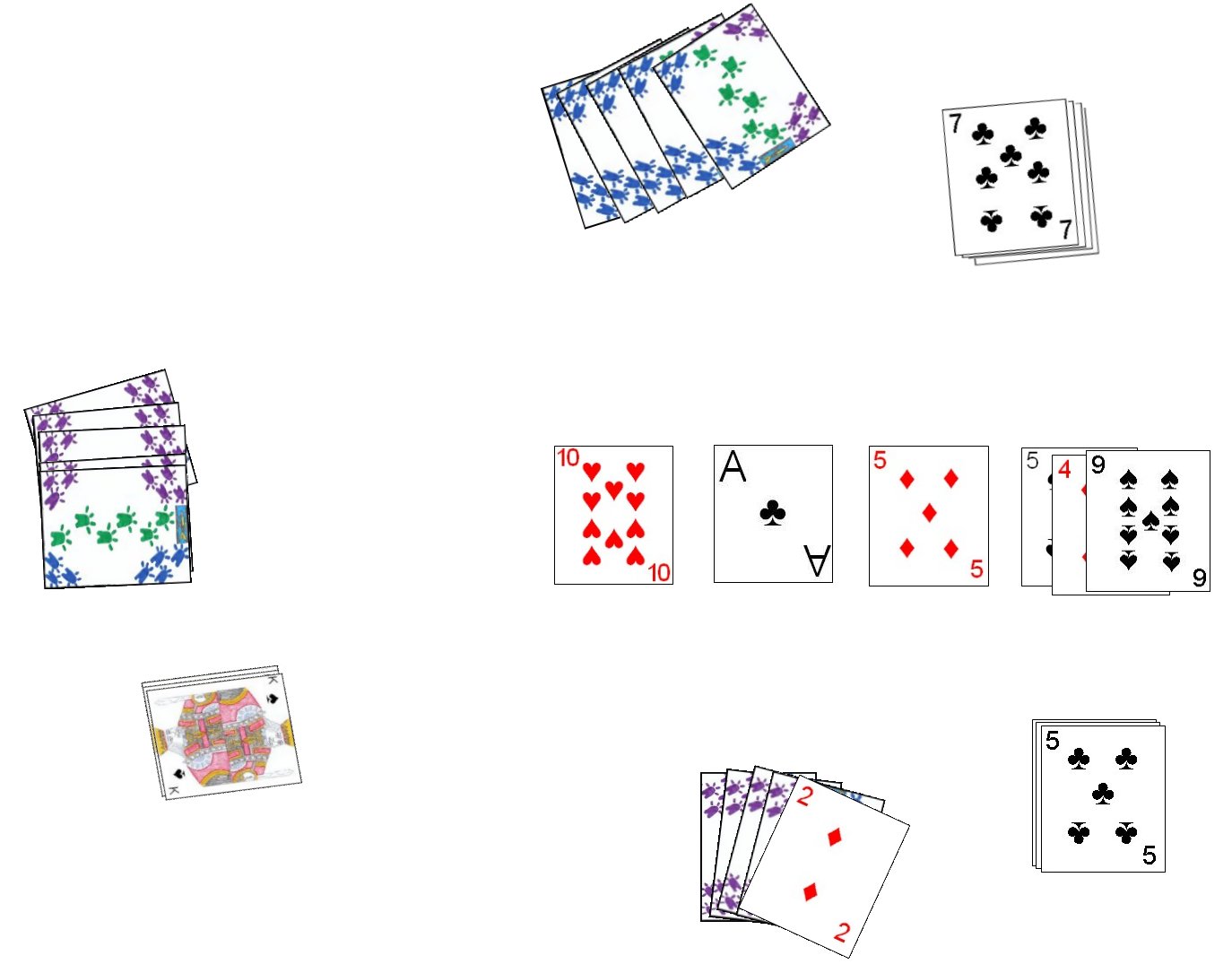
|
| In this example, a player augments a build of nines using a two from their own hand and a seven from an opponent's capture pile. |
Lastly, a player, on his turn, can
Augment a build. Augmenting a build is simply adding one or more cards to the build that is the same total as that of the current build. You may normally only augment builds that are currently owned by you or your partner (in the partnership version), however if you capture the build in the same turn, you may augment an opponents build. You may add a card from your hand as well as cards from the table to augment the build. Furthermore, when augmenting a build, the top card of an opponents capture pile may be used to assist in this endeavor. Only the topmost card of an opponents capture pile is allowed to be accessed at one time. However, if the next exposed card in the pile could be used with another card (from the hand or the table) to further augment the build, that is permissible.
When capturing cards or builds, the player places all the captured cards in one neatly stacked face up pile (called his capture pile). He may arrange this pile as he wants when capturing cards, but the actual card used to make the last capture must always be the top, faced card of the pile. In the partnership version, each partnership contains just one pile for the partnership, which may be set in front of either of the partners. As can be seen in the rules above, this topmost card can then be potentially captured by opponents augmenting a build on the table.
When an Ace is used in a build, the player playing it must announce the
builds value (which indicates the value of the Ace in it). Once set in
this way, the value of that card must remain the same until the card is
captured. When an Ace is the top card of a players capture pile, an
opponent may use it as either 1 or 14 at his option.
When all cards have been played, the uncaptured cards remaining on the table are collected by the last player to have made any type of capture.
After this, the hand is scored as per the following chart:
| Scoring Category | Scoring Value |
|---|
| Player or Partnership Having the Most Captured Cards | 2 |
| Player or Partnership with the Most Captured Spades | 2 |
| Capturing the Two of Spades (called Spy Two) | 1 |
| Capturing the Ten of Spades (called Big Ten) | 2 |
| Each Ace Captured | 1 Point Each |
If there is a tie between one or more players (or partnerships) for most cards or most Spades captured, the tying players would each score 1 point for the category. The first player or partnership to score 11 or more points at the end of a hand is declared the winner. If two or more players reach or exceed 11 points in the same hand, the scores are calculated in the following strict order (first to last): Most Cards, Most Spades, Spy Two, Big Ten, Spade Ace, Club Ace, Ace of Hearts then Ace of Diamonds.
Two Player African Cassino:
Although played very similarly to the standard African Cassino variant, there are several differences when the game is played by two.
The deck, determination of first dealer, shuffle and ranking of the cards is identical to standard African Cassino. The non-dealer has the first turn, with the deal alternating between both players.
As in the standard version, four cards are pulled out from the center of the deck to form the layout on the table. However, with two players each player receives only 12 cards. When those 12 cards have been played, the next batch of 12 cards is dealt.
A player may never discard to the center of the table while they have any uncaptured builds on the table. At the end of a players turn, that player may never have more than one uncaptured build on the table.
In all other respects the game is identical to standard African Cassino.
Partnership African Cassino:
African Cassino also makes a great four player version. When played by four, the game is played in two partnerships of 2 players each with one score kept for each team. The partners should each sit directly across from their teammate.
The rules for four player, partnership African Cassino are identical to the standard rule with a few exceptions:
One score is kept for each partnership. In addition, each partnership has only one capture pile. This pile may be kept in front of either of the partners.
Under most circumstances a player may never create, increase or augment a build in which they do not have a card which could capture this build (in effect, creating a potential build for their partner). However, in one
very specific instance a player can make a build that their partner must capture; If a player's partner had a build that the opponents increased (thus preventing the player from capturing it) his partner may make or increase an existing build to be that same value that his partner can then capture. A player may also request that his partner not capture a specific build during a turn (such the player himself can capture it), but his partner is not necessarily obliged to fulfill the request.
Eléwénjewénómbàjenómbà: Eléwénjewénómbàjenómbà may have the honor of being the card game with longest single word name. Eléwénjewénómbàjenómbà is a Nigerian fishing type game which is most popular in the Yorùbá
Land area. This game uses one standard 52 card deck to which two Jokers have been added, creating a deck consisting of 54 total cards. The standard game can be played by two,
three, four, or six players. A five player variant is also
described further below. However if using the more rigid "professional
rule set", only two players participate (this professional rule set is
also described further below). The rules first described are for what is called the "amateur" version of the game.
Eléwénjewénómbàjenómbà is played similarly to several other versions of Cassino described on this page, however it also has multiple differences from those games which makes it distinctly unique from other games in this family. The game is sometimes listed as Elewenjewe to conserve space and make the game somewhat easier to spell and pronounce.

|
| These same four cards always comprise the starting palette layout for playing Eléwénjewénómbàjenómbà. |
Determination of seating positions and first dealer can be determined in a number of ways, with draw for high cards a common method. The players would thus seat themselves at the table in order from highest to lowest card drawn. The player drawing the highest card of all is set as the first dealer. Thereafter, the role of dealer rotates around the table in a clockwise direction.
Before the shuffle, cut, and deal the dealer first removes four specific cards from the deck which are place face-up on the table to start the layout (called the palette). These cards are the
nine, Jack, Queen, and King, all in the suit of diamonds. This same layout is always used at the start of a new hand. After this special layout is placed on the palette, the dealer shuffles the remaining cards then offers it to the player at his immediate right cut. After the cut he then begins dealing the cards starting with the player at his left and continuing in a clockwise direction around the table. The dealer thus deals each player a face-down packet of four cards. The dealer then places the remainder of the deck to the side, for further deals during this hand. However, before adding the deck to the table, he should remove two cards from the bottom of that deck, without viewing them, and set them aside out of play. This is done such that the cards will deal out evenly amongst the players.
Play begins with the player to the immediate left of the dealer, and the turns continue in a clockwise direction around the table. Each turn consists of the player playing exactly one card from his hand to the table with the goal to capture cards from the central palette. With this in mind, there are several types of play which can be made with this card:
- Scooping:
Also known as scoping, this play consists of capturing
one or more other cards from the table. Such a capture can be made if the
card played matches the same rank as a card found on the table. If a card is
captured in this way, both the card played and the card captured are added
to that players capture pile. Another way in which cards can be captured
from the table is if two or more other cards on the table all sum to exactly the total of the card played. If the card played can make multiple captures, this is also allowed, thus a player could capture a combination of cards which sum to this value and another card which was of the same rank as the card played. Note that only Jacks,
Queens and Kings cannot be played to perform a capture in this way and
cannot themselves capture other cards through summing, these cards can only be captured through matching
play of cards of the same rank.
The two Jokers are special cards which, when played to the table
on a players turn, entitle that player to capture all the cards currently found on the table (called Ipalemo). However, if there are currently no cards left on the table and a Joker is played, the Joker must remain on the table, but can be taken by the next player to make a valid capture from the table.
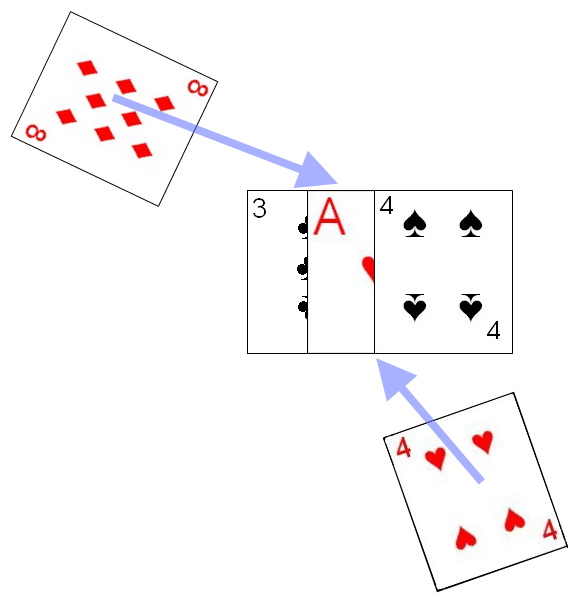
|
| This protected pile could be potentially captured by either a four or an eight. |
- Esun:
Esun is the equivalent of building in other Cassino variants. Thus, the card played can be combined with one or more cards already found on the palette to create a stack of cards of a certain value. Once combined in this way, this pile can never be added to or split. This pile of cards can be captured by
either a card equaling the total value of the pile, or alternatively, if
the pile has multiple groups of cards within it that add to the value of the
played card (for example a pile created which consists of a 3, Ace and 4
could be captured by either an eight for the entire total, or play of
another 4 which would match the existing 4 on the table and also the 3 and Ace
which sum to four). A player creating such a pile, however, must have a card remaining in his hand with which he could capture this protected pile on a later turn. If the player creating this pile fails to take it before the next batch of cards are dealt or the end of the game (whichever comes first) he loses one point, which is accomplished by immediately removing one card from the offenders capture pile and adding that card face-up to the center of the table to which it can be captured by any player as any other card might be. The use of the Esun rules is optional, and not always used by players
of this game. Thus, before the game begins it should be decided on whether the Esun rules will be used during the upcoming game.
- Capture Esun:
On his turn a player may capture an existing Esun on the table, either created by himself or by an opponent. As mentioned, this card can be captured by either the play of a card totaling the entire sum of the pile, or by a card which each there are multiple sums in the group which equal the played card.
- Trailing:
If a player cannot or elects not to make any of the previously mentioned plays, they simply play a card from the hand, face-up to the table.
The game continues until each of the players has played each of his four cards. The dealer then deals each player an additional packet of four cards, but does not add any additional cards to the center of the table. Play continues as before, with each player playing one card from his hand to the table on his turn.
The hand ends after the stock is exhausted and the last player has played his last card. Any cards remaining on the table after the last played are automatically added to the capture pile for the last player to have a turn during this hand.
After this, each player scores exactly one point for each card he managed to capture during the hand. These points are added to an ongoing score for each player. After exactly four hands have been played, the winner of the game is the player who has accumulated the most total ongoing points from the four hands.
Another optional rule sometimes adopted in play is that of the Isiwo
rule. If the Isiwo rule is allowed and used in a particular game, players are entitled to look through the pile of cards that they have captured, but never those of any other player. This can be helpful in determining which cards might still be remaining in the deck or other player's hands. If the Isiwo rules are not in use during a game, a player is never allowed to look at his previously captured cards and doing so causes a penalty of one point to that player. This is usually enforced by immediately removing one card from that player's captured cards pile and placing it face-up on the palette, where it can be captured by any player during his turn.
Eléwénjewénómbàjenómbà - Professional Rules The rules described above for this game are what are normally called the amateur rules,
which is also the most common version of this game usually played. Under the professional
rule set, there are several differences in gameplay:
- The game is always played by exactly two players. Thus, the "professional" game would never be played by more than two participants.
- Jokers are never used in the professional game. As such, after the deal two cards are not removed and set aside out of play as in the amateur game.
- The professional game consists of exactly three rounds.
In all other aspects the professional rules are the same as the normal game as described further above.
Yorùbá Rules: Another rule set which is sometimes used is that Yorùbá
rule set. This rule set can be used in addition to either the amateur or the
professional rule set. The Yorùbá rules enforce one additional stipulation. Thus, if using Yorùbá rules, in capturing a sum of cards from the table, the cards being used to sum to the value of the played cards may never contain more than one card of the exact same denomination. Additionally, if
the Esun (building) option is allowed during this game, an Esun pile can never contain more than one card of any specific denomination and cannot be captured by a card of the same denomination as any card in the Esun pile. Other than that difference, this variant of the game is played identically to either the amateur or professional rules as used for the game.
Five Player Eléwénjewénómbàjenómbà: As mentioned above, a five player variant of this game can also be
played. The five player variant can be played with either the standard or
slightly more stringent Yorùbá rule set. The only difference
(other than the number of participants) being that with the five player
variant, if Jokers are included, two cards are not removed from the deck
after the initial deal. Instead, on the final deal of the hand, each player only receives a packet consisting of
exactly two cards (vice the usual four cards). In all other aspects the five player variant is played identically to the normal game as described above.
Shaniss: Shaniss is a Somalian game which is played similarly to
Cassino and it's variants. Shaniss is designed for play by two
participants using one standard 52 card deck. The game was first described in print in a 1912 publication titled
British Somaliland, authored by Ralph Evelyn Drake-Brockman.
Once the first dealer is determined for the hand, this player should thoroughly shuffle the cards which are then cut by his opponent. The dealer then begins by dealing four face-down cards to each player (starting with his opponent), and then deals four face up cards to the center of the table. The opponent of the dealer has the first turn.
On each turn, a player plays one card from his hand to the center of the table. In certain circumstances the player of the card may be able to capture cards from the table. The following are legal captures a player can make:
- If there are one or more cards on the table of the exact same denomination as the card played, the player
of that card may capture all cards of that denomination from the table, including his card played.
- If there is a combination of two or more cards which add to the same value as the card played, he may take all such combinations of cards, as well as his card played.
A player may also take combinations of these captures. For instance, if he played an eight, and there was a 5, 3, 8, and King on the table, the player could take the five and three (which total eight) as well as the single eight, adding them to his capture pile along with his card played. All cards captured, including the card played to make the capture are added to that player's capture pile.
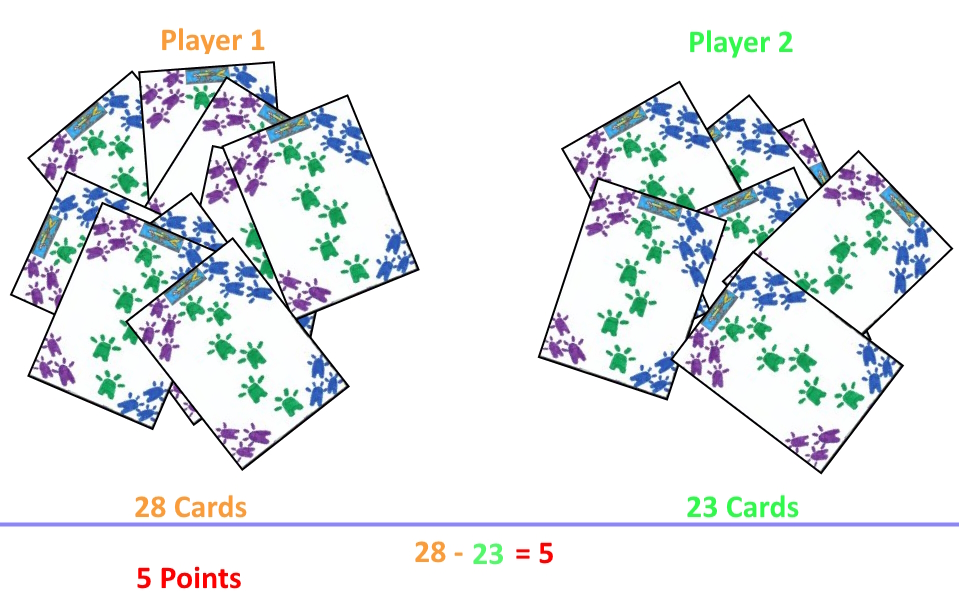
Kings, Queens, and Jacks have no capture value and thus can only be captured by another card of that same rank (a King can capture another King, a Queen can capture a Queen,
and a Jack captures another Jack). Aces have a capture point value of 1 and the cards of rank 2 to 9 have a point capture value equal to the actual number marked on the card.
If a player can make no legal captures on his turn, he simply leaves his card played face-up on the table, to add to the center layout.
Once both players have played the four cards as found in their hand, the dealer deals each player another four cards total. The players then continue play using these four additional cards. The dealer continues dealing additional cards until the entire deck has been dealt and played, after which time scoring for the hand is accomplished. Any uncaptured cards left on the table at the end of a hand are not claimed by either player.
Both players add up the total number of cards captured during the hand. The player which captures the greater number of cards earns a number of points equal to his total number of cards captured during that hand subtracted from the number of cards captured by his opponent. This amount is then added to that player's ongoing score.
Once either player, after calculating the scoring for the hand reaches or exceeds 100 points, that player is immediately declared the game winner.
Kazsinó: Kazsinó, also known as Hungarian Cassino is a unique variant of the game Cassino which allows players to play multiple cards on the same turn. This variant is the most common variant of this game type played in Hungary. Kazsinó is designed for play by two players and uses one standard 52 card deck. Each card in the deck has a value associated to it.
Thus, the value of each numbered card is equal to the number printed on
the card while Aces have a value of 1, Jacks 11, Queens 12, and Kings 13.
Determination of the first dealer as well as seating positions can be performed using any of the methods used for other variants of the game. Once the players have been seated and the dealer has such been determined this player deals three face-down cards to each player as their initial hand, and four face-up cards to the table. He then sets the remainder of the deck aside for use later in the hand.

The opponent of the dealer has the first play. On a player's turn he plays one or more cards from his hand to the middle of the table in an effort to capture cards from this center layout. If the sum total value of cards played by the player on his turn equals the sum total of one or more cards from the table, he may capture these cards, adding them to his captured cards pile along with the cards played. However, the maximum value in cards a player can play on one play is 13. If the player has no card or combinations of his card that equal to the sum of one or more cards on the table (or chooses not to play one) he simply plays one card from his hand, placing it face up on the table. After his play, that player's opponent then has the next turn.
If a player, after playing multiple cards to the table has no cards remaining in his hand, and his opponent still has cards remaining, that player then takes one or more turns in succession to play the remainder of his cards to the table, also making captures if able.
After each player has played all three of their cards over the course of one or more turns, if there are any remaining cards in the deck, the designated dealer for that hand deals three additional cards to each player. The opponent of the player to have made the last capture during the hand takes the next turn. Once the deck has been depleted, the players simply play out the remainder of the hand using the last three cards dealt. In dealing the last batch of three cards to each player from the remaining deck, these last three cards should be dealt face-up in front of each player, instead of the usual face-down. The players play as normal from these face-up hands. After all cards have been dealt and played, if there are any cards remaining in the center layout, the last player to have made a capture is entitled to add these cards to their capture pile (but this does not score for a sweep).
If a player, during a turn, manages to capture every card from the table, this entitles him to earn one point for a sweep. This is usually indicated by drawing an extra line on the scoring sheet for that player. After a sweep, the opponent of the player making the sweep takes two
consecutive turns. If a player manages to make a sweep of the first four initial cards, that player earns two points for that sweep.
In addition to scoring for sweeps, the following additional scores can be earned during or at the end of play:
- Whichever player manages to capture the most cards during the hand scores 3 points. If each player captures exactly 26 cards, no player earns these points on the hand.
- The player whom manages to capture the ten of diamonds earns 2 points.
- Which player manages to capture the most cards in the suit of spades (♠), earns one point.
- Whichever player captures the two of spades earns 1 point.
- Each Ace captured during play earns one point.
Although these points are added to a player's score, at any time during the game, if a player believes his current score would be equal to or greater than 11 points (which is needed to win) may announce this by shouting
"Ausz!". In that case, play immediately stops and the points counted. If the player was correct he
immediately wins the game, even if his opponent may have also reached or exceed 11 points. However, if the player failed to reach at least 11 points, his opponent is declared the winner instead. If a player manages to earn 11 or more points during the first deal (one full run of the entire deck), he is said to have won a double game.
Stealing Bundles: This is a common game, often played by children that is a predecessor to learning to play Cassino. Stealing bundles can be played by from two to four players.
After determining the first dealer (high card draw), this dealer deals two cards face down to each player, clockwise around the table. After each other player has two cards, he deals two cards face up to the center of the table. He then deals two cards face down to himself. This dealing pattern is then repeated, such that each player (including himself) has four cards and there are four face-up cards in the center. He also places the remainder of the pack face down near the center to form the stock pile.
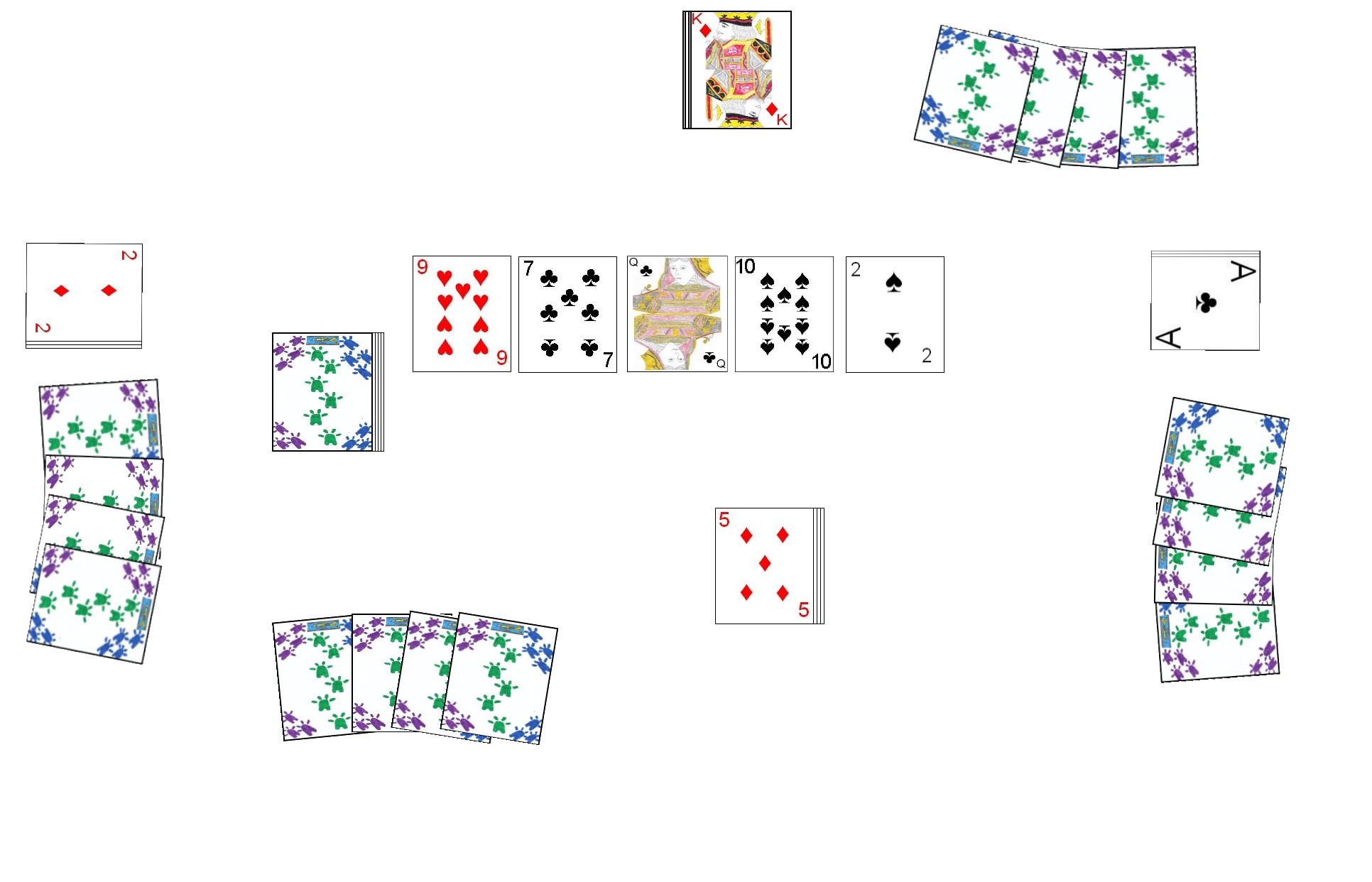
|
| This figure shows the basic layout for the game of Stealing bundles (with a possible game in progress). Displayed are the center cards, each players individual face up bundle, the draw pile and each players four card hand.
|
The player to the dealers immediate left begins play and thenceforth play continues clockwise around the table.
On his turn a player must play one card from his hand. He can do several things:
- Capturing From the Table: If a player can play a card that matches the rank of one or more cards in the center of the table they may capture all these matching cards. These cards, along with the card from the hand, are placed face up in a neat pile, called a bundle, in front of the player who made the capture. If this player already has cards from previous captures in front of him, he places the new cards on top of these on the bundle.
- Capturing From another Player: If the player's card matches the top card of any other players bundle, he may capture that other players bundle. When this happens, he takes that players entire bundle pile and places it on top of his own bundle (if he already has one) with the matching card from his own hand at the top of the bundle.
- Trailing: If a player is unable to capture another players bundle or any cards from the center, they simply place a card face up on the table.
When all the players have played the last of the four cards from the deal, the players then each draw cards from the stock pile. This occurs with each player drawing a card one at a time starting with the player to dealers immediate left. This continues until each player again has four cards and play resumes.
When the last card of the entire hand is played, the game ends. The player who has the most cards in their bundle is declared the winner of the game.
Each hand is a complete game and the player to the immediate left of the previous dealer deals the next.
Zwickern: Zwickern is a somewhat simpler version of Cassino that originated in North Germany and is still played there today. It is designed to be played by two to eight players. The traditional deck to be used for the game is one standard 52 card deck in which 6 Jokers have been added. However, if extra Jokers are not obtainable, it can easily be played with a standard deck with just 2 or 4 Jokers added. In fact, for games with 5 or more players, it is usually recommended to include no Jokers at all.
As in many of the games of this same type, each of the cards has a comparative value for used in summing up for captures from the center of the table. The following chart shows the value of each card in the deck:
| Card | value |
|---|
| King | 14 |
| Queen | 13 |
| Jack | 12 |
| Ace | 11 |
| 2, 3, 4, 5, 6, 7, 8, 9, 10 | Value marked on card |
| Joker | 2 to 14 at players option |
Designation of seating positions and first dealer can be done using any method, with drawing for high cards a common method. Once the first dealer has been determined, this player should then deal four face-down cards to each player, one at a time in a clockwise rotation. After each player (including himself) has the requisite four card, he then deals four face-up cards to the center of the table (called the Tableau or Bild). He then sets the remainder of the deck to the side for use later in the hand.
The player to the immediate left of the current dealer has the first turn. The object of the game, as in most other games of this type, is to capture the point scoring cards from the tableau, using cards from the hand. Thus, on his turn, a player plays one card from his hand. He may capture cards from the center of the table in certain cases, as follows:
- Pairing:
If there is any card on the table of the exact same rank, he may take both his played card and the card from the table and add the card to his own capture pile which is set aside to be used for determining scoring at the end of the hand.
- Summing:
If the total value of two or more cards on the table equals the sum of his card played, he may take his played card as well as all those that sum to the same total and add them to his capture pile.
A player may take any and all captures that his played card entitles him to, so may capture all cards that are of the same rank as well as any individual groups of cards that sum to the total value of his played card. If a player manages to take all cards from the table on his turn (called a Sweep or Zwicker) he is entitled to bonus points at the end of the hand. When playing a Joker, the player may designate the value
that this card is intended to be (stating the value aloud). Similarly, if a Joker is found in the Tableau, a player on his turn may take it by simply stating it contains the value of the card he played. If a player is unable to capture any cards from the table, he also has two options:
- Trailing:
Trailing consists of simply adding the card to the Tableau, not directly on top of any cards already on the tableau.
- Building:
A player may place the card slightly on top of another card on the table. This causes the value of those cards to be increased to the sum of both cards. Additional cards could be added to this build (from players' hands), during additional turns as well, however the total value of a build may never exceed 14. This Build may then be captured by another card of the same rank as the total value of the build.
If a player runs out of cards at the end of his turn, he draws four new cards from the stock. However, if the stock has fewer than four cards remaining, he takes all that remain. Once the stock is depleted he simply drops from the game. Once the stock is exhausted and each player, in turn, has taken his last turn, the players examine the capture piles to determine the scoring for the hand.
After each hand the scores are calculated for the hand. The following chart shows the scores that can be acquired during the hand:
| Scoring Condition | Scoring Value |
|---|
| Capturing the Seven of Diamonds | 1 Point |
| Capturing the Seven of Spades | 1 Point |
| Each Ace Captured | 2 Points Each |
| Ten of Diamonds | 10 Points |
| Each Sweep or Zwicker | 3 Points Each |
| Capturing the Most Total Cards | 1 Point |
|
|
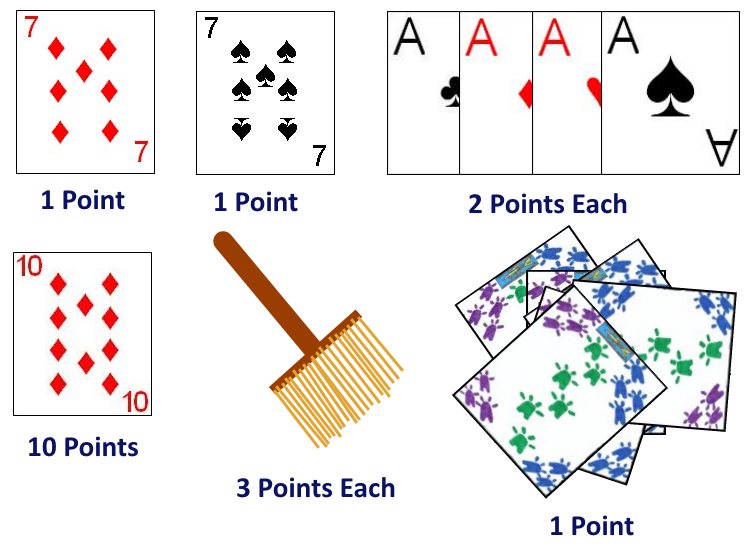 |
If players tie for the most cards, no player scores for that category. The player who has earned the most points during the hand is declared the winner.
Bella Donna: Bella Donna is a fishing type game, played similarly to Cassino and it's variants that originated in the island nation of Malta. Bella Donna is designed for play by two players, using one standard 52 card deck.
Determination of seating positions and first dealer can be performed as in Cassino, with the role of dealer then alternating amongst the two players. The designated dealer then thoroughly shuffles the deck and offers it to his opponent to cut. After the cut the dealer then begins dealing the cards, first dealing four face-down cards to his opponent, then four face-down to himself. He then deals four cards face-up to the center of the table and sets the remainder of the deck aside as the stock.
Play then alternates between the two players, starting with the opponent of the dealer. On each turn a player will play one card from his hand to the center of the table, usually in an attempt to capture one or more cards from the center
layout. A card played can thus capture cards from the center of the table in the following conditions:
- If there is a card in the center layout which is of the exact same ranking as the card played he may take both this card and his card played, adding them to his capture pile. If there are multiple cards of this rank in the layout, the player may only opt to capture one such card.
- If there are two or more cards, which sum to the total value of the card played to center by the player, he may take those cards that sum to this total as well as his card played, adding them to his capture pile. A player may only capture one such combination with any specific card played. Jacks, Queens and Kings have no equivalent value, Aces are equivalent to one, and each other card has a value equal to the number as marked on that card, for purposes of this summing capture.
A player may only make one type of capture on his turn, but may always choose which capture to make, and is never required to make a capture, even if one is available on the layout. Players
normally keep their captured cards in neat, face-up capture piles in
front of themselves, to assist in convenient scorekeeping at the end of the hand.
The player would thus have one individual capture pile for each point
score (i.e. one pile for zero point scoring cards, another for cards
with a scoring value of one point, etc.).
As in most other games of this type, there are certain point scoring cards which players will attempt to capture during the hand:
- Red (cards in the suit of hearts or diamonds) cards in the denomination of Ace, King, Queen, Jack, and 10 each earn two points at the end of the hand.
- Red cards in the denomination of 2, 3, 4, 5, 6, 7, 8, and 9 each earn the capturer one point.
- All black cards (cards in the suit of clubs or spades) normally have a
scoring value of zero points at the end of the hand.
There are certain situations in which the value of these captured cards, however, is increased, as follows:
- Fixxa: A player able to capture the card in the layout that was most
recently played by the previous player on that player's last turn earns a bonus of +1 point for
all cards captured in this way (including the card used to make the capture). Thus,
all black cards are worth 1 point each, lower denomination red cards 2 points
each and higher denomination red cards 3 points each.
- Stoppa: A player who manages to capture any and all cards currently found on the layout earns a Stoppa. The scoring value of a Stoppa is the same as for a Fixxa (which includes the card making the capture) providing a +1 point value for each card captured in the Stoppa.
After each player has played the four cards initially dealt to him,
the dealer then again deals each player four additional card from the
stock, but no additional new cards to the center layout. The opponent of the dealer then has the first turn and the play alternates amongst the two players until they have both played these four cards, with the dealer again dealing four more cards from the stock. This continues until the stock has been exhausted and the players have played the last four cards have been dealt. Once this occurs, the last player to have made a legal capture from the board is also entitled to take any remaining cards in the layout. The player each then add the total number of points they were able to capture and earn during the hand to a cumulative total number of points. Multiple such hands are played until one or both players have reached or exceed some total, such as 150 points. When this occurs, the player with the highest grand total is declared the game winner.
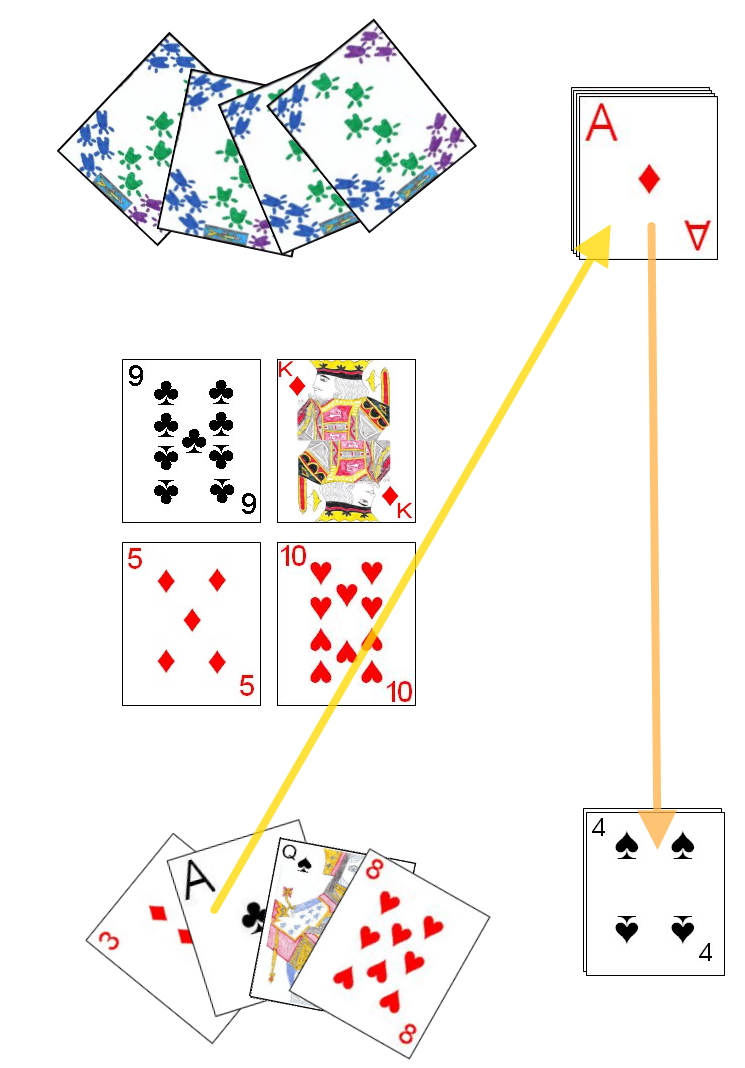
|
| This figure shows an example of one player capturing his opponent's captured cards pile through play of a card from the hand. |
Bella Donna Halliel: Bella Donna Halliel (or Bella Donna Ħalliel) is a unique variant of Bella Donna which allows a player to capture his opponent's entire capture pile with one simple play. As in standard Bella Donna, this variant is designed for two players using one standard 52 card deck. The game is played identically to standard Bella Donna except for the following differences which can have a significant effect on gameplay:
- Each player keeps all captured cards during the hand in one face-up pile on the table in front of himself. As cards are captured by a player from the center of the table, all cards captured (including the card played from the hand to make the capture) are added face-up to the top of that players capture pile. The card from the hand used to make the capture should be set as the very top card of that pile.
- If a player has in his hand, a card of the exact same rank as the top card of his opponent's capture pile may thus play that card to the top of that opponent's capture pile, capturing the entire pile, and thus placing that captured pile, face-up on top of his own capture pile.
Other than this minor difference which can, however, have a huge impact on the strategy used by the participants
during play, Bella Dona Halliel is played identically to Bella Donna as describe immediately above.
Laugh and Lie Down: Laugh and Lie down is a very early game which follows the same basic concept as Cassino and some of it's other variants, that of attempting to capture as many cards as possible. It is thought to be the first documented game of this type and is described and mentioned in literature from at least as early as 1665.
Laugh and Lie Down uses one standard 52 card deck and is designed to be played by five players. There is no real concept of ranking of the cards in this game although the standard ranking is used for determination of seating positions and first dealer. To determine this, each
player draws a card from the shuffled pack and seat themselves in the order of the draw, from lowest to highest. If two or more players draw cards of equal rank, those players should discard those cards and draw again until drawing
each of those player draws a card of a unique denomination. The player who draws the lowest ranked card of all becomes the first dealer. After each hand, the deal rotates in a
clockwise rotation around the table. Scoring in this game is traditionally done with chips, so before play begins, each player should be provided an equal number of chips, such as 25.
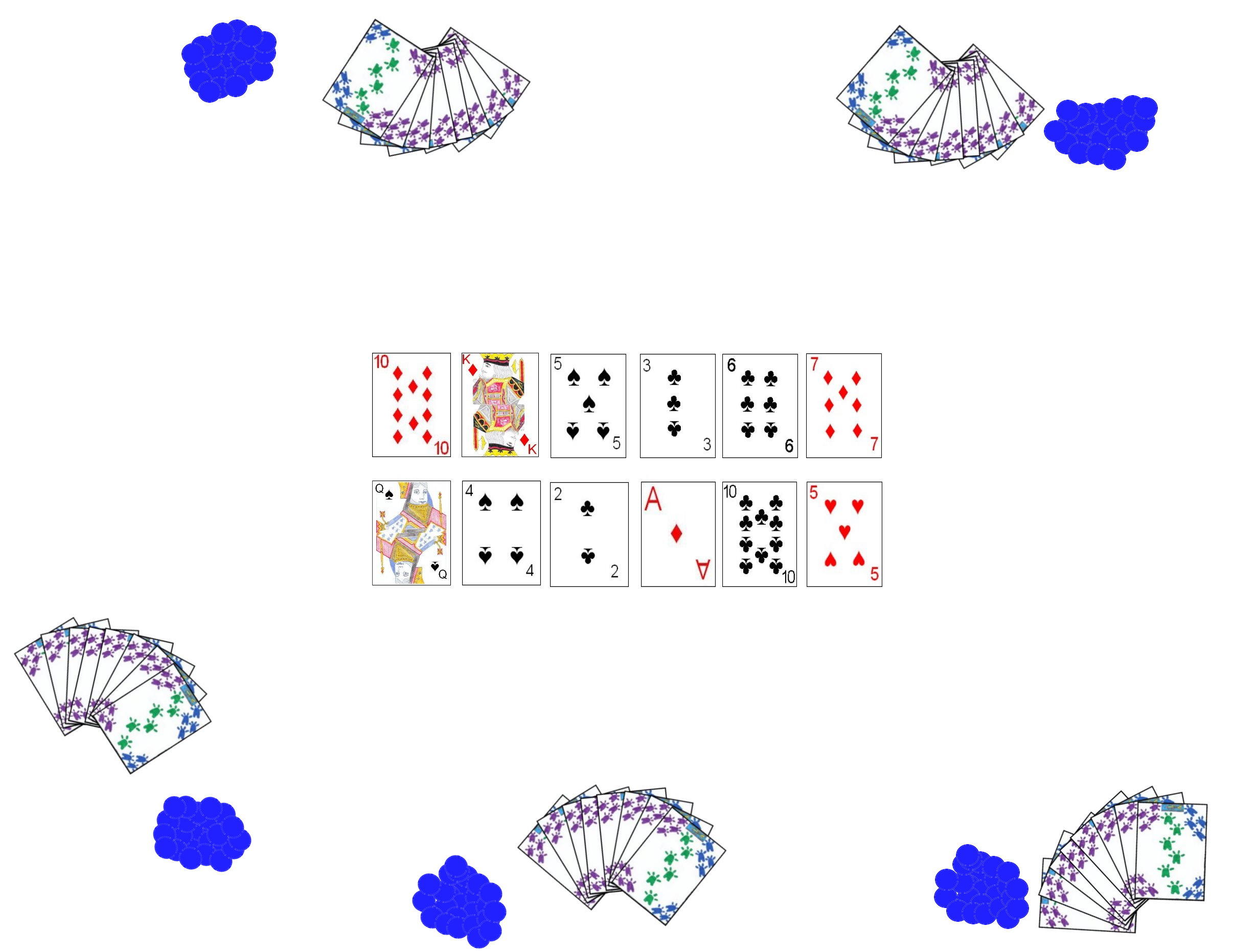
Once the players are seated and the first dealer determined, this dealer should thoroughly shuffle the deck and begin the deal. He deals a total of eight face-down cards to each player starting with the player to his immediate left. After each player has eight cards, he places the remainder of the cards, individually and face-up in the middle of the table, which is the capture area. After the deal, the dealer must place 3 chips to the center of the table, and each of the other players must place 2.
If the twelve cards initially dealt to the center of the table consists of any Mournivals (four cards of the exact same denomination) the dealer can capture these immediately, placing them face-up in front of himself at the table, to be considered in the scoring at the end of the hand. In addition, if any players have a Mournival in hand he immediately adds it to his own capture pile. Similarly, if a player has a Prial (three cards of the exact same denomination) in hand, he may add two of these cards immediately to his own capture pile, retaining the third card of the Prial in hand.
Play starts with the player to the dealer's immediate left. The object of the game is to capture cards by matching cards on the table with cards from the hand. Thus, on a player's turn he must play one card from his hand, usually attempting to capture cards of that same denomination. A card played may capture one or three cards of the same
denomination that are already on the table. Cards captured are added to that player's captured pile, ending his turn. Similarly, if a player has a Pair in his hand (two cards of the exact same denomination), and the other pair of the same denomination is already on the table, the player may play his pair which captures the other pair, adding all four cards to his captured pile. If a player has a pair in his hand and another player captures the first pair of that denomination, the player holding that second pair of the same denomination may immediately add the pair to his own capture pile, as he would have no other opportunities to capture that pair.
If, on your turn, you are unable to make at least one capture from the table, you must "Lie Down" your hand. This consists of placing the remainder of your entire hand face-up on the table, and the other players traditionally are to laugh at this player who was forced to drop his hand (thus the name of the game). This player then drops from the hand, but he still retains his captured cards for scoring purposes at the end of the hand.
A player may also capture cards from the table if he manages to notice a valid capture that may have been missed by another player on his turn. This includes such things as an uncaptured Mournival, a player who captures just one of three cards of the same rank on the table or a player who Lays down his hand
which contains a Mournival or a pair that could have previously been captured.
Once all players but one have been required to "Lie Down" their hands, the hand ends with the scoring taking place. The last player who holds cards is entitled to add to his capture pile all cards currently in his hand as well as all cards still found
on the table. Scoring of the hand then occurs.
The last player to have cards during the hand collects 5 chips from the center pile. In addition, players can earn points (or lose points) based on the number of cards they were able to capture. For every two cards a player has captured over eight, he is entitled to collect 1 point (chip) from the pile in the center of the table. However, for each two cards less than 8
that the player captured during the hand, he must add one chip to the center pile.
A variant of this game was also described in the original documented rules for four players. The four player variant is played identically to the standard five player version, with the following differences:
- Each player receives 10 face-down cards from the dealer and the last 12 cards from the deck are placed face-up on the table.
- The last player to retain cards in the hand wins 3 chips from the center pile.
- For each two cards a player has captured above 10, that player earns one chip from the center pile. For each two cards under 10 he manages to capture during the hand, he must add one chip from his own pile to the center pile.
Copyright © 2015 CatsAtCards.com. All rights reserved.
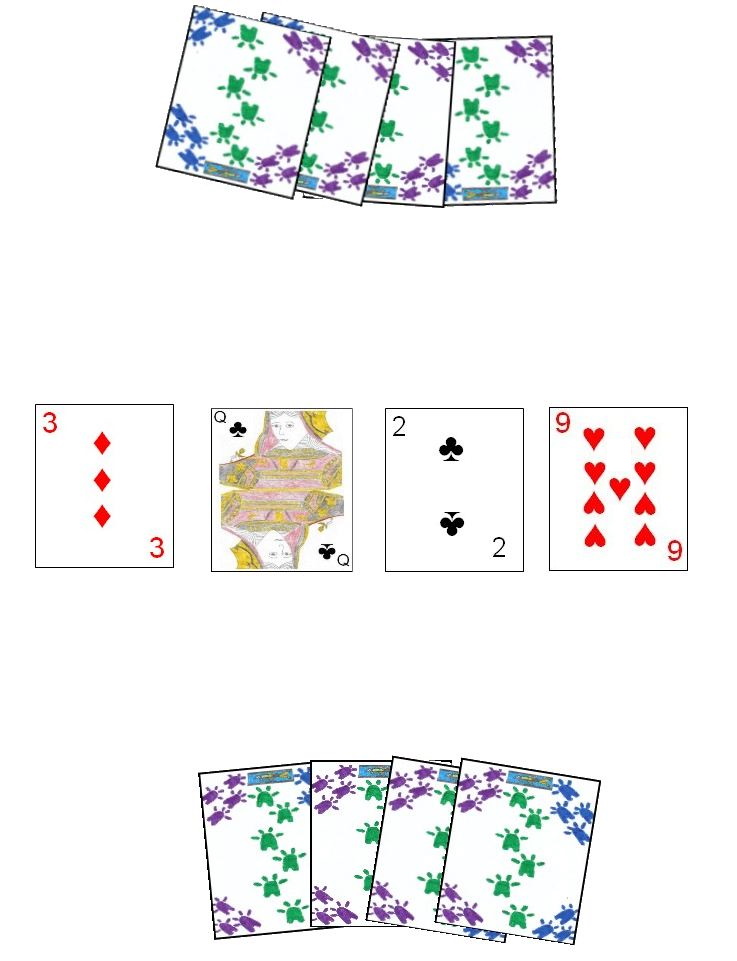













 Kings, Queens, and Jacks have no capture value and thus can only be captured by another card of that same rank (a King can capture another King, a Queen can capture a Queen,
and a Jack captures another Jack). Aces have a capture point value of 1 and the cards of rank 2 to 9 have a point capture value equal to the actual number marked on the card.
Kings, Queens, and Jacks have no capture value and thus can only be captured by another card of that same rank (a King can capture another King, a Queen can capture a Queen,
and a Jack captures another Jack). Aces have a capture point value of 1 and the cards of rank 2 to 9 have a point capture value equal to the actual number marked on the card.
 The opponent of the dealer has the first play. On a player's turn he plays one or more cards from his hand to the middle of the table in an effort to capture cards from this center layout. If the sum total value of cards played by the player on his turn equals the sum total of one or more cards from the table, he may capture these cards, adding them to his captured cards pile along with the cards played. However, the maximum value in cards a player can play on one play is 13. If the player has no card or combinations of his card that equal to the sum of one or more cards on the table (or chooses not to play one) he simply plays one card from his hand, placing it face up on the table. After his play, that player's opponent then has the next turn.
The opponent of the dealer has the first play. On a player's turn he plays one or more cards from his hand to the middle of the table in an effort to capture cards from this center layout. If the sum total value of cards played by the player on his turn equals the sum total of one or more cards from the table, he may capture these cards, adding them to his captured cards pile along with the cards played. However, the maximum value in cards a player can play on one play is 13. If the player has no card or combinations of his card that equal to the sum of one or more cards on the table (or chooses not to play one) he simply plays one card from his hand, placing it face up on the table. After his play, that player's opponent then has the next turn.



 Once the players are seated and the first dealer determined, this dealer should thoroughly shuffle the deck and begin the deal. He deals a total of eight face-down cards to each player starting with the player to his immediate left. After each player has eight cards, he places the remainder of the cards, individually and face-up in the middle of the table, which is the capture area. After the deal, the dealer must place 3 chips to the center of the table, and each of the other players must place 2.
Once the players are seated and the first dealer determined, this dealer should thoroughly shuffle the deck and begin the deal. He deals a total of eight face-down cards to each player starting with the player to his immediate left. After each player has eight cards, he places the remainder of the cards, individually and face-up in the middle of the table, which is the capture area. After the deal, the dealer must place 3 chips to the center of the table, and each of the other players must place 2.